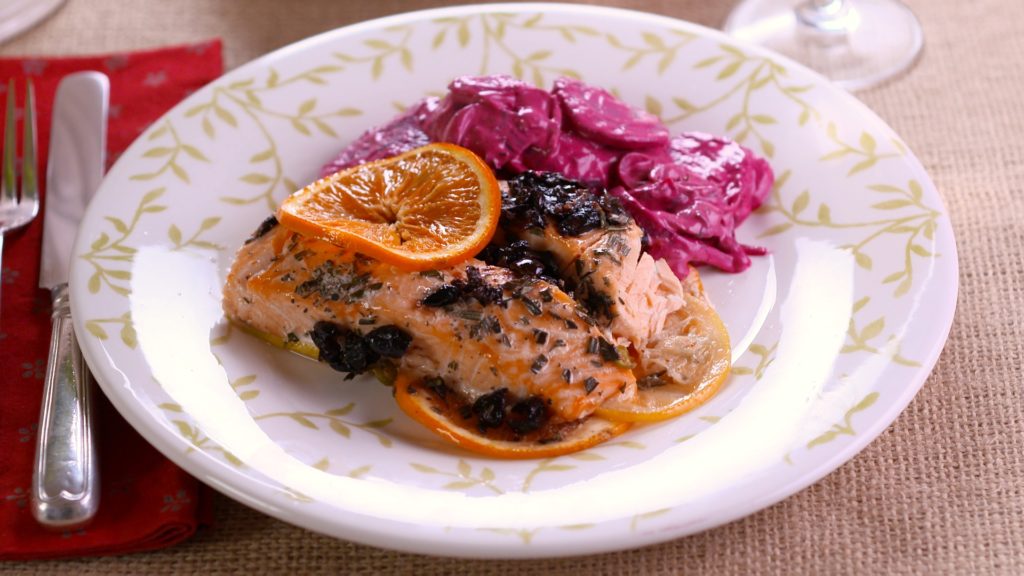
Start to finish: 45 minutes
Hand-on time: 25 minutes
Servings: 4
1 small orange, sliced very thin plus 2 tablespoons fresh juice
1 small lemon, sliced very thin plus 2 tablespoons fresh juice
4 (4- to 5-ounce) skinless center-cut salmon fillet pieces
Kosher salt and freshly ground black pepper
1/4 cup fresh rosemary, chopped
2 tablespoons extra-virgin olive oil
1/2 cup olives, preferably oil cured, pitted and chopped
1 small serrano chile, sliced thin, crosswise
Preheat the oven to 400°F.
Place a large piece of parchment paper, 24 inches long and 13 inches wide, on a sheet pan and fold it in half crosswise. Open the paper, put the right half of the parchment on top of a sheet pan (letting the left half hang off) and arrange half the orange and lemon slices about 2 inches to the right of the center fold in a rectangle shape, about the size of the four pieces of salmon laid next to each other (perpendicular to the crease).
Season the salmon on both sides with salt and pepper. Sprinkle half the rosemary on top of the citrus and top the rosemary with the four pieces of salmon. Drizzle the citrus juices and olive oil on top. Distribute the chopped olives and sliced chile evenly over the four pieces of salmon and top each piece with the remaining rosemary and the remaining orange and lemon slices.
Bring the left half of the parchment up and over the salmon to completely cover it. Starting at the top left of the parchment package, make 1/4-inch folds all around the perimeter and press to crimp and seal, until you have completely encased the salmon.
Bake the wrapped salmon on the sheet pan on the middle shelf of the oven for 12 to 14 minutes or until it is just cooked through (you can stick a knife through the parchment and salmon and if it goes easily that means the fish is done).
Cut open the parchment, knock off the citrus slices and transfer the salmon pieces to each of 4 plates. Spoon some of the olives, chile slices, rosemary, and juices from the bottom of the parchment over each piece and serve right away.
COOK’S NOTES: How to Cook in a Bag
Is It Done? The only tricky part about cooking en papillote is that you can’t see when the fish is done. If you slice open the bag, you risk losing some of the delicious sauce that’s coming together. My solution is to start with the basic rule of baking fish: In a 400°F oven, bake the fish 10 minutes for every 1 inch of thickness. I stick a very sharp, thin knife right through the parchment and down through the fish as soon as it hits the 12-minute mark. No resistance or very little? The fish is done. Significant resistance? Bake it for a few more minutes. (By the way, this test works well regardless of how you cook the fish.)
Make a Meal in a Bag. Let’s say you wanted to make a whole meal in a bag, sort of like a high-toned TV dinner. In that case, I would make two bags, each with two pieces of fish, and then add some substantial vegetables, for example sautéed mushrooms, steamed cooked potato cubes, blanched broccoli or carrots.
If you do add vegetables, they’ll need to be pre-cooked. The denser vegetables (like carrots and broccoli) simply won’t become tender during the short time the package is in the oven. Similarly, if wetter veggies (mushrooms and spinach, for example) aren’t pre-cooked, they’ll end up watering down the sauce.
Premade Bags. Pre-made culinary parchment paper bags (made by Paper Chef) are much more widely available these days than they used to be. This recipe includes instructions on how to fold the paper to make a bag yourself, but if you can find the pre-made ones, grab them. I experimented with a pre-made bag while testing this recipe and discovered that it worked perfectly well. You just layer all the ingredients in the bag, fold the bottom under to seal the package, and bake away.
Culinary Parchment Bags (3 pack)
Borscht Beets
Serves 4 to 6
Hands-of prep time: 15 minutes
Total prep time: 1 hour (longer if using oven method)
2 pounds beets scrubbed and all but 1 inch of the tops removed
1 1/2 teaspoons kosher salt
1/3 cup balsamic vinegar
1 teaspoon sugar
1 teaspoon caraway seeds
1/2 small red onion sliced paper-thin
1 cup sour cream or low fat yogurt
1 tablespoon chopped fresh dill
Additional kosher salt and freshly ground black pepper to taste
Place beets in a large sauce pan and add enough cold water to cover.
Add 1 teaspoon of the salt and bring to boil over high heat. Reduce the heat to medium high and simmer until tender, 45-50 minutes. (Alternatively, preheat the oven to 350 F, wrap the beets individually in foil, and roast for 1 1/2 to 2 1/2 hours or until tender.)
While the beets are cooking, combine the remaining 1/2 teaspoon salt, the vinegar, sugar and caraway seeds with the onion in a small saucepan. Bring to a boil and remove from the heat.
Remove the beets from the water and set aside until cool enough to handle. Peel, slice thin, and toss with onion mixture. Stir in the sour cream and dill and season with salt and pepper to taste. Serve at room temperature.
COOK’S NOTES:
Preparing Beets
Use the old egg slicer to slice cooked beets. It is also a great tool for slicing cultivated mushrooms or an avocado that you quarter first.
Handling Beets
To keep your hands from getting stained while preparing beets (and if you hate those surgical gloves as much as I do), rub your hands with vegetable or olive oil before you start. It will keep your hands protected.
How to Cook the Beet Greens
A nice way to cook beet greens is to saute them in olive oil and garlic and then squeeze some fresh lemon juice on top. Wash the greens and then remove the leafy part from the stems and chop the stems. Heat the oil in a large skillet, add the stems first and saute them for a few minutes. The add the leafy greens and the garlic and saute for a few more minutes or until tender. Season with salt and pepper and the lemon juice.






